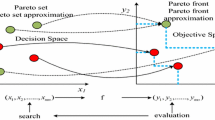Abstract
Unit commitment (UC), as a typical optimization problem in electric power system, faces new challenges as energy saving and emission reduction get more and more important in the way to a more environmentally friendly society. To meet these challenges, we propose a UC model considering energy saving and emission reduction. By using real-number coding method, swap-window and hill-climbing operators, we present an improved real-coded genetic algorithm (IRGA) for UC. Compared with other algorithms approach to the proposed UC problem, the IRGA solution shows an improvement in effectiveness and computational time.
Similar content being viewed by others
Abbreviations
- a i , b i , c i :
-
Energy consumption function parameters of the ith unit
- CSC i :
-
Cold start-up cost of the ith unit
- CST i :
-
Cold start-up time of the ith unit
- \(D_{R_i }\) :
-
Down ramp limit of the ith unit, MW/h
- D t :
-
Demand during hour t, MW
- G :
-
Number of units
- HSC i :
-
Hot start-up cost of the ith unit
- i :
-
Unit index (i=1, 2, ⋯, G)
- K i,t :
-
Start-up cost of the ith unit
- MDT i :
-
Minimum down-time of the ith unit
- MUT i :
-
Minimum up-time of the ith unit
- P i,t :
-
Power output of the ith unit for hour t
- P min i :
-
Minimum generation limit of the ith unit, MW
- P max i :
-
Maximum generation limit of the ith unit, MW
- r i,t :
-
Operation status of the ith unit for hour t (1 = “on”, 0 = “off”)
- R i :
-
Power-purchasing expense of the ith unit
- s i :
-
Emission efficiency factor which represents the percent of pollutants handled by environmental apparatus
- \(S_{D_t }\) :
-
Reserved requirement during hour t, MW
- t :
-
Hour index (t=1, 2, ⋯, T)
- T :
-
UC horizon
- T on i :
-
Duration during which the ith unit is continuously on
- T off i :
-
Duration during which the ith unit is continuously off
- u :
-
Coefficient of energy consumption which represents the cost for energy compensation when consuming unit resource (e.g. coal)
- \(U_{R_i }\) :
-
Up ramp limit of the ith unit, MW/h
- α i :
-
Emission factor, kg/MW
- δ i :
-
Operation status of the ith environmental equipment (1 = “on”, 0 = “off”)
- ρ :
-
Coefficient of handling pollutants
- φ i :
-
Expense of environmental equipment handling pollutants
- ω :
-
Environmental value of pollutants which represents the cost for handling pollutants of each unit
References
Salam S. Unit commitment solution methods [J]. World Academy of Science, Engineering and Technology, 2007, 1(11): 290–295.
Ongsakul W, Petcharaks N. Unit commitment by enhanced adaptive Lagrangian relaxation [J]. IEEE Transactions on Power Systems, 2004, 19(1): 620–628.
Chuang C S, Chang G W. Lagrangian relaxationbased unit commitment considering fast response reserve constraints [J]. Energy and Power Engineering, 2013, 5: 970–974.
Yuan X, Su A, Nie H, et al. Unit commitment problem using enhanced particle swarm optimization algorithm [J]. Soft Computing, 2011, 15(1): 139–148.
Simopoulos D N, Kavatza S D, Vournas C D. Unit commitment by an enhanced simulated annealing algorithm [J]. IEEE Transactions on Power Systems, 2006, 21(1): 68–76.
Dudek G. Adaptive simulated annealing schedule to the unit commitment problem [J]. Electric Power Systems Research, 2010, 80(4): 465–472.
Jalilzadeh S, Pirhayati Y. An improved genetic algorithm for unit commitment problem with lowest cost [J]. Intelligent Computing and Intelligent Systems, 2009, 1: 571–575.
Dudek G. Unit commitment by genetic algorithm with specialized search operators [J]. Electric Power Systems Research, 2004, 72(3): 299–308.
Datta D. Unit commitment problem with ramp rate constraint using a binary real-coded genetic algorithm [J]. Applied Soft Computing, 2013, 13(9): 3873–3883.
Damousis I G, Bakirtzis A G, Dokopoulos P S. A solution to the unit commitment problem using integer-coded genetic algorithm [J]. IEEE Transactions on Power Systems, 2004, 19(2): 1165–1172.
Author information
Authors and Affiliations
Corresponding author
Additional information
Foundation item: the National Natural Science Foundation of China (Nos. 61004088 and 61374160)
Rights and permissions
About this article
Cite this article
Pan, Q., He, X., Cai, Yz. et al. Improved real-coded genetic algorithm solution for unit commitment problem considering energy saving and emission reduction demands. J. Shanghai Jiaotong Univ. (Sci.) 20, 218–223 (2015). https://doi.org/10.1007/s12204-015-1610-2
Received:
Published:
Issue Date:
DOI: https://doi.org/10.1007/s12204-015-1610-2




